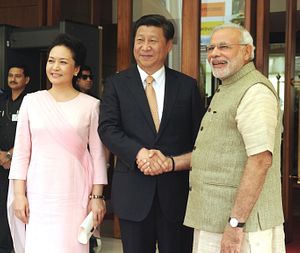Narendra Modi is en route to China, marking his first visit there since becoming India’s prime minister last May. Modi will begin his visit in Xi’an, where he will be greeted by Chinese President Xi Jinping in an unusual break of protocol (Xi normally receives foreign leaders in Beijing, the country’s capital). After a day in Xi’an, Modi will spend Friday in Beijing before heading to Shanghai. The visit will run the gamut of issues at the top of the India-China bilateral agenda, including economic ties, strategic issues, and the contentious topic of the border disputes between the two countries.
As a matter of diplomatic protocol, China generally equates Indian prime ministers with Chinese premiers. As Ananth Krishnan notes in India Today, Modi’s reception in Xi’an by Xi is unique not only for the sake of the venue, but also because of this presumed change in protocol. Xi greeting Modi outside of Beijing, interestingly, draws a parallel to Modi’s unconventional decision to greet Xi in Gujarat instead of New Delhi during his September 2014 visit to India.
Modi and Xi will hold bilateral talks in Xi’an on the afternoon of May 14. On Friday, Modi will meet with China’s premier, Li Keqiang. In Beijing, Modi and Li will oversee the signing of numerous memorandums of understanding (MoUs) on economic cooperation and investment. Trade between India and China stands at around $70 billion, but the balance is largely in China’s favor. Modi and Xi, during their meetings in India last year, expressed an interest in growing their trade partnership.
Also on Friday, Modi will address Chinese students at Tsinghua University in Beijing. His visit will also emphasize cultural linkages between India and China; both he and Li are expected to attend a celebration of Indian Yoga and Chinese Tai Chi in Beijing. Ahead of his visit to China, Modi started to build a presence on China’s Sina Weibo social networking service in a bid to communicate directly with ordinary Chinese Internet users. (His initial post of “Hello China!” received over 19,000 likes and 12,000 replies.)
On Saturday, Modi will head to Shanghai, China’s commercial heart, to deliver a public address that was in part organized with the help of the Indian community in the city. India media are comparing the nature of Modi’s Shanghai speech to his speech at New York City’s Madison Square Garden in September 2014. Around 4,000 people are expected to attend. Modi will also meet with Chinese business leaders to pitch his “Make in India” initiative — a regular occurrence on his diplomatic trips abroad since the initiative was announced. Modi will also inaugurate the first center for Gandhian studies at Fudan University while in Shanghai.
While both governments are emphasizing the primacy of economics on the bilateral agenda for this state visit, both sides have indicated that Modi and Xi will discuss the contentious issue of the border disputes between India and China. The two countries dispute the final status of Aksai Chin and Arunachal Pradesh, the former being under China’s administration and the latter under India’s. In recent years, incursions by Chinese People’s Liberation Army troops across the Line of Actual Control demarcating the unofficial boundary between Chinese-occupied Aksai Chin and India have caused tensions to rise between the two countries. The latest serious incursion occurred during Xi’s visit to New Delhi last September. Most experts are not expecting a major breakthrough on the border issue in the wake of this visit; both Indian and Chinese observers expect any diplomatic process to be lengthy and difficult.
Modi’s China visit will test the extent to which he and his Chinese counterparts will be able to build trust and initiate a sustainable diplomatic process toward resolving the bilateral territorial dispute. In strategic terms, India and China face other tensions. Indian strategists see China’s forays into the Indian Ocean and Central Asia as threatening to New Delhi’s interests. Modi embarked on a three-nation tour of the Indian Ocean in March, ostensibly to counter growing Chinese influence in the region. New Delhi also remains concerned about China’s relationship with Pakistan — the two states are close allies and Xi recently visited Islamabad. (Just two days before Modi’s scheduled visit, an editorial authored by Pakistani Prime Minister Nawaz Sharif appeared in China’s state media, extolling the virtues of China’s involvement in Pakistan.)
China, meanwhile, is concerned about India’s convergence with the United States and growing involvement in the South China Sea. New Delhi has close ties with Southeast Asian states, and its state oil company has agreements with Vietnam’s government to explore sea blocks for hydrocarbons in disputed waters. The Modi government recalibrated India’s long-standing “Look East” policy last year, framing its approach to East Asia as an “Act East” policy. While China is included in this vision, it is difficult for Beijing to ignore New Delhi’s growing ties with states that have their own suspicions about Chinese foreign and security policy, particularly in the East and South China Seas.
Modi’s trip to China is part of a broader East Asian tour. He will visit Mongolia on Sunday, becoming the first Indian prime minister to do so. Modi will then spend May 18-19 in South Korea, concluding his trip.
































